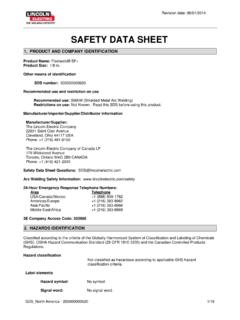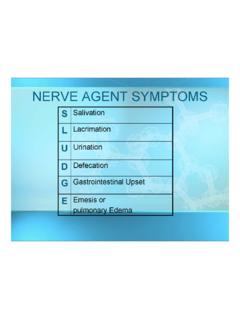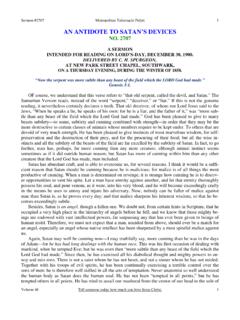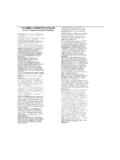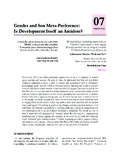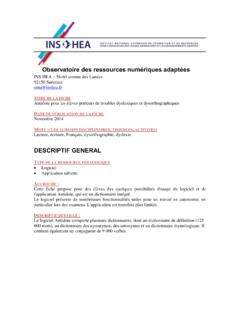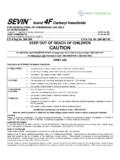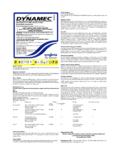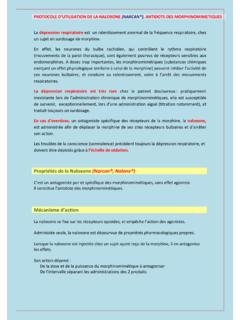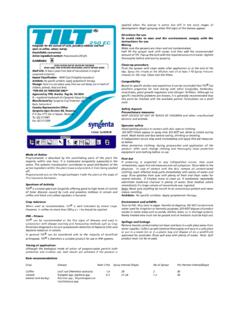Transcription of Material Safety Data Sheet - Weld-Tech Products
1 Oxygen (Gas) 3/LASAL 2003 Various/Special atmospheres for Safety data SheetProduct nameSynonymTrade nameMaterial usesIn case of emergencyProduct and company identificationPrepared byOxygen (Gas) :CAS number:7782-44-7(514) 878-1667 Air Liquide Canada , Ren -L vesque West, Suite 1700 Montreal, QC H3B contact. Eye contact. overviewHazards identificationRoutes of entryPotential acute health effectsMay cause eye irritation. Contact with rapidly expanding gas may cause burns or this product is a gas, refer to the inhalation cause skin irritation. Contact with rapidly expanding gas may cause burns or stateGas. [Compressed gas.]::::: chronic health effectsSignal wordOXIDIZER. CONTACT WITH OTHER Material MAY CAUSE FIRE. HIGH PRESSURE gas under pressure. In a fire or if heated, a pressure increase will occur and the container may burst or explode. Keep away from combustible Material . Do not puncture or incinerate container. Avoid breathing gas. Use only with adequate ventilation.
2 Keep container tightly closed and sealed until ready for use.:DANGER!Hazard statements:Precautions::No known significant effects or critical :No known significant effects or critical known significant effects or critical known significant effects or critical effects:No known significant effects or critical :Teratogenicity:No known significant effects or critical effects:1/9 Canada6/1 (Gas)Hazards conditions aggravated by over-exposureNone known.:No known significant effects or critical signs/symptomsIngestion:No specific :No specific :No specific :No specific effects:Composition/information on ingredientsOxygen7782-44-7100 NameCAS number% are no additional ingredients present which, within the current knowledge of the supplier and in the concentrations applicable, are classified as hazardous to health or the environment and hence require reporting in this this product is a gas, refer to the inhalation for and remove any contact lenses. Immediately flush eyes with plenty of water for at least 15 minutes, occasionally lifting the upper and lower eyelids.
3 Get medical attention case of contact, immediately flush skin with plenty of water for at least 15 minutes while removing contaminated clothing and shoes. Wash clothing before reuse. Clean shoes thoroughly before reuse. Get medical attention aid measuresEye contactSkin contactIngestionNo specific treatment. Treat symptomatically. Contact poison treatment specialist immediately if large quantities have been ingested or to physician::::Antidote informationNo antidote information knownProduct/ingredient nameAntidote of first-aiders:No action shall be taken involving any personal risk or without suitable training. It may be dangerous to the person providing aid to give mouth-to-mouth :Move exposed person to fresh air. If not breathing, if breathing is irregular or if respiratory arrest occurs, provide artificial respiration or oxygen by trained tight clothing such as a collar, tie, belt or waistband. Get medical attention an extinguishing agent suitable for the surrounding measuresExtinguishing mediaContains gas under pressure.
4 Contact with combustible Material may cause fire. This Material increases the risk of fire and may aid combustion. In a fire or if heated, a pressure increase will occur and the container may burst or :Not suitable:Flammability of the product:2/9 Canada6/1 (Gas)Fire-fighting isolate the scene by removing all persons from the vicinity of the incident if there is a fire. No action shall be taken involving any personal risk or without suitable training. Contact supplier immediately for specialist advice. Move containers from fire area if this can be done without risk. Use water spray to keep fire-exposed containers protective equipment for fire-fightersFire-fighters should wear appropriate protective equipment and self-contained breathing apparatus (SCBA) with a full face-piece operated in positive pressure mode.:Special exposure hazards:Hazardous thermal decomposition Products :No specific action shall be taken involving any personal risk or without suitable surrounding areas.
5 Keep unnecessary and unprotected personnel from entering. Shut off all ignition sources. No flares, smoking or flames in hazard breathing gas. Provide adequate ventilation. Wear appropriate respirator when ventilation is inadequate. Put on appropriate personal protective equipment (see Section 8). If leak is in user's equipment, be certain to purge piping with an inert gas prior to attempting repairs. Never fix a leak while the system is under pressure. If leak is on container or container valve, contact the closest Air Liquide Canada contact emergency personnel. Stop leak if without risk. Use spark-proof tools and explosion-proof equipment. Note: see Section 1 for emergency contact information and Section 13 for waste precautionsAccidental release measures:Ensure emergency procedures to deal with accidental gas releases are in place to avoid contamination of the environment. Inform the relevant authorities if the product has caused environmental pollution (sewers, waterways, soil or air).
6 Personal precautions:Large contact emergency personnel. Stop leak if without risk. Use spark-proof tools and explosion-proof spill:Methods for cleaning upProtect cylinders from physical damage. Store in cool, dry, well-ventilated area of non combustible construction away from heavily trafficked areas and emergency exits. Do not allow the temperature where cylinders are stored to exceed 52 C/125 F. Cylinders must be stored upright and firmly secured to prevent falling or being knocked over. Full and empty cylinders should be segregated. Use a "first in - first out" inventory system to prevent full cylinders being stored for excessive periods of time. See NFPA 430, Code for the Storage of Liquid and Solid Oxidizers. Store in accordance with local in a segregated and approved area. Store in a dry, cool and well-ventilated area,Put on appropriate personal protective equipment (see Section 8). Eating, drinking and smoking should be prohibited in areas where this Material is handled, stored and processed.
7 Workers should wash hands and face before eating, drinking and contaminated clothing and protective equipment before entering eating gas under pressure. Avoid contact with eyes, skin and clothing. Avoid breathing gas. Keep away from combustible Material . Keep reduction valves free from grease and oil. Valve protection caps must remain in place unless cylinder is secured with valve outlet piped to usage point. Do not drag, slide or roll cylinders. Use a suitable hand truck for cylinder movement. Use a pressure regulator when connecting cylinder to lower pressure piping or systems. Do not heat cylinder by any means to increase the discharge rate of product from the cylinder. Use a check valve or trap in the discharge line to prevent hazardous back flow to the cylinder. Do not tamper with (valve) Safety device. Close valve after each use and when and (Gas)Handling and from incompatible materials (see Section 10). Protect from sunlight. Separate from reducing agents and combustible materials.
8 Keep container tightly closed and sealed until ready for controls/personal protectionUse a properly fitted, air-purifying or air-fed respirator complying with an approved standard if a risk assessment indicates this is necessary. Respirator selection must be based on known or anticipated exposure levels, the hazards of the product and the safe working limits of the selected eyewear complying with an approved standard should be used when a risk assessment indicates this is necessary to avoid exposure to liquid splashes, mists or dusts. If contact is possible, the following protection should be worn, unless the assessment indicates a higher degree of protection: Safety glasses with protective equipment for the body should be selected based on the task being performed and the risks involved and should be approved by a specialist before handling this protectionEyesSkinRespiratoryConsult local authorities for acceptable exposure limits.:::Chemical-resistant, impervious gloves complying with an approved standard should be worn at all times when handling chemical Products if a risk assessment indicates this is necessary.
9 Considering the parameters specified by the glove manufacturer, check during use that the gloves are still retaining their protective properties. It should be noted that the time to breakthrough for any glove Material may be different for different glove manufacturers. In the case of mixtures, consisting of several substances, the protection time of the gloves cannot be accurately measures:Good general ventilation should be sufficient to control worker exposure to airborne measures:Wash hands, forearms and face thoroughly after handling chemical Products , before eating, smoking and using the lavatory and at the end of the working techniques should be used to remove potentially contaminated contaminated clothing before reusing. Ensure that eyewash stations and Safety showers are close to the workstation monitoring procedures:If this product contains ingredients with exposure limits, personal, workplace atmosphere or biological monitoring may be required to determine the effectiveness of the ventilation or other control measures and/or the necessity to use respiratory protective equipment.
10 Reference should be made to appropriate monitoring to national guidance documents for methods for the determination of hazardous substances will also be exposure controls:Emissions from ventilation or work process equipment should be checked to ensure they comply with the requirements of environmental protection legislation. In some cases, fume scrubbers, filters or engineering modifications to the process equipment will be necessary to reduce emissions to acceptable exposure limitsNo exposure limit value (Gas) C ( F)Gas. [Compressed gas.]Not C ( F) [Air = 1]Not C ( F)32 pointMelting/freezing pointNot and chemical propertiesPhysical stateMolecular weightpHCritical temperatureVapor pressureVapor densityOdor thresholdEvaporation rateViscositySolubilityOdorColorO2 Molecular formula:::::::::::::::Flash point:Not available.:Auto-ignition temperatureFlammable limits:Not :Not g/ solubility (g/l):The product is stable. Under normal conditions of storage and use, hazardous decomposition Products should not be specific and reactivityChemical stabilityConditions to avoidIncompatible materialsHazardous decomposition of hazardous reactions:Hazardous reactions or instability may occur under certain conditions of storage or may include the following:contact with combustible materialsReactions may include the following:risk of causing or intensifying fireReactive or incompatible with the following materials: oxidizing materials, reducing materials and combustible normal conditions of storage and use, hazardous polymerization will not (Gas)Toxicological toxicityNot toxicityNot toxicityNot informationToxicity of the Products of biodegradationNot ::Partition coefficient: n-octanol/ :This product shows a low bioaccumulation factor:Not ecotoxicityNot adverse effects.
